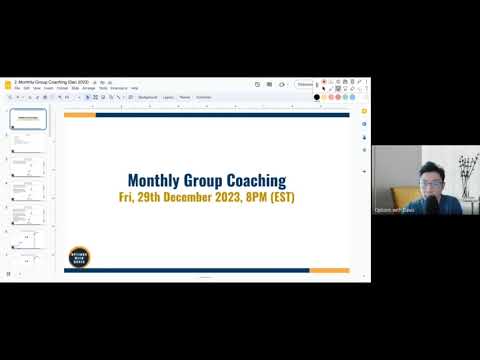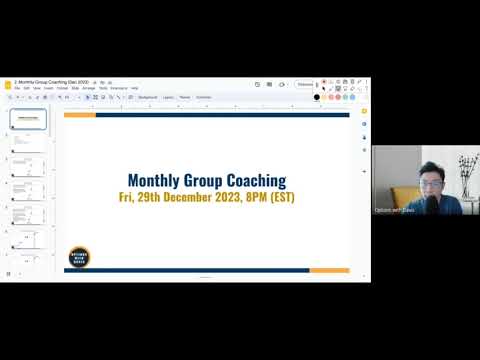Okay, so let’s get started with the OptionsWithDavis Dec 2023 Training Call. First of all, welcome to the monthly Group coaching for this month. We all know that this month has been pretty challenging for us due to the market going all the way up. The training call, hosted by OptionsWithDavis and created by Heating & Cooling Solutions, will discuss the market conditions in December 2023 and how it affects trading strategies. The speaker will cover topics such as market overview, entry tactics, performance evaluation, understanding drawdown, and reducing upside risk. Additionally, they will address questions related to rolling trades, reducing risk in a bull market, and unwinding assigned positions. The main focus is on sticking to the strategy and focusing on long-term probabilities. So, are you ready to dive into these important topics? Let’s get started!
Market Conditions in December 2023

Overview of the Challenging Market Conditions
Welcome to the December 2023 training call. As we all know, this month has presented some challenging market conditions. The market has primarily been on an upward trend, which has had an impact on our trading strategies, specifically on the call side of our iron condor structure. In this article, we will discuss the various market conditions we are currently facing and how they affect our trading strategies. We will also explore different trading strategies and entry tactics that can be effective in these conditions.
Impact on Trading Strategies
The challenging market conditions in December 2023 have forced us to adapt our trading strategies. The market has been consistently moving upwards, which puts our call options at risk. This requires us to adjust our strategies to minimize losses and protect our investments. We need to explore different trading strategies and entry tactics that can help us navigate these challenging market conditions effectively.
Trading Strategies and Entry Tactics
Exploring Different Trading Strategies
To mitigate the impact of the challenging market conditions, it is crucial to explore different trading strategies. One strategy that can be effective in these conditions is the neutral iron condor. By placing the iron condor near the income grid levels, we ensure that our trades are well spaced apart. This vertical diversification allows us to take advantage of different market levels and increases our chances of success.
Identifying Effective Entry Tactics
Finding the right entry point in the market is crucial, especially in challenging conditions. For neutral trades, it is recommended to wait for the market to touch the income grid levels before entering the trade. This ensures that our structures are well spaced out and increases the probability of catching profitable trades. In bullish trades, it is safer to enter below the income grid levels. This reduces the downside risk and provides a more favorable entry point for bullish strategies.
Performance Evaluation
Importance of Evaluating Performance
Evaluating performance is crucial in any trading strategy, especially during challenging market conditions. By regularly analyzing and assessing our trades, we can identify areas of improvement and make necessary adjustments to maximize profits and minimize losses. Performance evaluation allows us to track our progress, measure our success rate, and make informed decisions for future trades.
Metrics for Evaluating Trading Performance
There are several metrics to consider when evaluating trading performance. Some common metrics include win-to-loss ratio, average return per trade, maximum drawdown, and risk-adjusted return. These metrics provide valuable insights into the effectiveness of our trading strategies and help us identify areas where we can improve. It is essential to track these metrics consistently to monitor progress and make informed decisions.
Understanding Drawdown
Definition and Explanation of Drawdown
Drawdown refers to the peak-to-trough decline in an investment’s value during a specific period. It measures the percentage loss from the highest point to the lowest point. Understanding drawdown is crucial because it helps us assess the risk involved in our trading strategies. By tracking drawdown, we can identify periods of underperformance and take necessary steps to manage risk effectively.
Managing Drawdown in Trading
To manage drawdown in trading, it is essential to have a well-defined risk management strategy in place. This includes setting stop-loss orders, diversifying the portfolio, and maintaining a disciplined approach to trading. Implementing proper risk management techniques can help reduce the impact of drawdown and protect our investments during periods of market volatility.
Reducing Upside Risk
Strategies to Minimize Upside Risk
Minimizing upside risk is crucial, especially in bullish markets. One strategy to reduce upside risk is to have a portfolio with long positive deltas. This can be achieved by adding positions that benefit from upward price movements. If you do not have a stock portfolio, there are other ways to create long positive deltas, such as using options strategies like call options and call spreads. By incorporating these strategies, we can protect our investments and minimize potential losses in bull markets.
Mitigating Losses in Bull Markets
In bullish markets, it is important to be mindful of the potential for losses. To mitigate losses, we need to closely monitor the market and adjust our positions accordingly. This may involve closing out positions that are no longer profitable or implementing hedging strategies to protect against downside risk. By actively managing our trades and being adaptive to market conditions, we can minimize losses and maximize profits in bull markets.
Rolling Trades
Explanation of Rolling Trades
Rolling trades refers to the process of closing out an existing position and simultaneously opening a new position with different strike prices or expiration dates. This strategy can be effective in adjusting our trades to current market conditions. By rolling trades, we can extend or reduce the duration of our positions and potentially improve our profit potential.
Benefits and Risks Involved in Rolling Trades
Rolling trades offers several benefits, including the ability to adjust our positions to changing market conditions, potentially improving profitability, and extending the lifespan of our trades. However, there are risks involved, such as increased transaction costs and potential losses if the market moves against our new position. It is important to carefully consider the pros and cons of rolling trades and assess the potential risks before implementing this strategy.
Reducing Risk in a Bull Market
Strategies to Lower Risk in Bull Markets
Lowering risk in a bull market requires a combination of careful analysis and strategic decision-making. One strategy is to diversify the portfolio by incorporating different asset classes or sectors. This spreads the risk and reduces vulnerability to any single market movement. Additionally, setting stop-loss orders and regularly reviewing and adjusting positions can help limit potential losses and protect investments during bull markets.
Protecting Investments during Bullish Trends
During bullish trends, it is crucial to protect our investments and manage risks effectively. This can be done by regularly monitoring the market and making informed decisions based on the available data. Implementing hedging strategies, setting profit targets, and adjusting positions as needed can help protect investments and maximize returns during bullish trends.
Unwinding Assigned Positions
Process of Unwinding Assigned Positions
Unwinding assigned positions refers to the process of closing out options positions that have been assigned. This typically occurs when options contracts are exercised by the counterparty. To unwind assigned positions, we can either sell the assigned options or offset the positions by entering into opposite trades.
Managing Risks Associated with Unwinding
Unwinding assigned positions comes with certain risks, such as potential losses if the market moves against our positions. It is important to carefully assess the market conditions and evaluate the potential impact before unwinding assigned positions. Implementing risk management techniques, such as setting stop-loss orders, can help mitigate these risks and protect our investments.
Sticking to the Strategy
Importance of Sticking to the Trading Strategy
Sticking to the trading strategy is crucial for long-term success. It helps maintain consistency and discipline, which are essential qualities for profitable trading. By following the strategy, we can avoid emotional decision-making and stay focused on the long-term probabilities. It is important to trust the strategy and make adjustments based on data and analysis rather than short-term market fluctuations.
Long-Term Probabilities and Focus
When it comes to trading, focusing on long-term probabilities is key. Short-term market fluctuations may cause temporary losses, but by focusing on the long-term probabilities, we can make informed decisions and increase our chances of success. It is important to avoid getting caught up in short-term emotions and stay focused on the overall strategy and objectives.
Conclusion
In conclusion, trading in challenging market conditions requires adapting our strategies and implementing effective entry tactics. It is crucial to evaluate performance, understand drawdown, and manage risks to protect our investments. By reducing upside risk, rolling trades, and sticking to the strategy, we can navigate challenging market conditions and increase our chances of long-term success. Remember to focus on long-term probabilities and make informed decisions based on thorough analysis.
